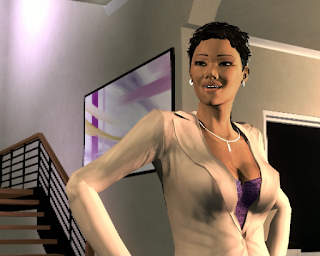Saints Row's Boss is Trans
Today is March 31st. Otherwise known as Transgender Day of Visibility. A day that is dedicated to the celebration of Transfolk and the injustices that they face. In honor of this glorious day, I have decided to touch upon something that I noticed when replaying Saints Row 2 last year. What I had noticed is that the Boss is canonically Trans. While this is a conclusion that some will not come to, the logic behind it makes sense. So, let's go through some history of the series and see how this is solidified and embedded in the franchise's design.
In Saints Row 1, the Player Character is known as Playa. This name is dubbed by the leader of the 3rd Street Saints, Julius Little. The ambiguousness behind the name allows the player to design Playa as they see fit. You get to decide on the skin tone, body size, haircut, etc. Some normal character creation tools that are found in other video game titles. But there is a major distinction that is found in SR1 that is not present in the other games. That distinction being the gender selection. There is no option for the Playa to be anything but Male.
So the Player must go throughout their journey and betrayal as a man. Regardless of this distinction, I would still recommend this game because of how good the story is. But getting back to the topic at hand. The Playa ends up becoming a top Lieutenant in the 3rd Street Saints. And in doing so, they are targeted by the one's that fear him. Ending the game by exploding on a Yacht with Richard Hughes, the main villain.
Yet that is not the end of the story for the Playa. The second game opens up with the revival of the Playa. Now known as the Boss. A truly iconic character in a game that features so many memorable moments. Along with the inception of the most important pieces to this feature. The inclusion of the female gender, as well as the location known as Image As Designed.
The character creator at the beginning of Saints Row 2 has all of the features found at Image As Designed. So if the player ever wanted to change the look of the Boss, they could. The important factor behind many of these important customization features involved them being available to both genders. This would entail everything except genitalia. Hair, voice, clothes are universal for example. This would end up applying for Saints Row: The Third and Saints Row IV as well. I cannot speak for the reboot, because I did not play it.
As far as character creation goes, this has been one of the most progressive I have seen. Which is both good and bad. Good because it shows that the Saints Row team has always been ahead of the curve. Yet this is also bad because SR2 came out in 2008. Hurts my bones as well as my soul. Like the bar isn't high, yet people still manage to not top an open-world game from SIXTEEN years ago. To get back on track, I am going to talk about how this reinforces the acceptance behind the Boss's identity and how the games avoid gendering them.
In SR2, you wake up in the medical ward of the Stillwater prison alongside Carlos. Carlos is a young kid who wants to join the Saints with the legendary Boss. His brother was a Saint and he bleeds purple. He helps to break you out and release the most powerful human in the universe on the city of Stillwater once again. The first person you go to meet after being in a coma is none other than Johnny Gat.
Your ole pal Johnny is about to get the chair. For good reason too. He's a psychopath and one of the most prolific killers known to man. But Johnny is family, and you don't turn your back on family. You show up to the court house and take Johnny home to his partner, Aisha. What stands out with the characters from the first game, is that many of them will comment on your appearance upon meeting you again. Johnny and Aisha make the same, "Did you do something with your hair", comment to the Boss.
There are many factors behind this sentiment. One, it is funny and acknowledging that Boss and Playa are different. The hair choices are vastly different, and you can change your gender to name a few. Two, it showcases an acceptance of the Boss as they are presented to them. Friends and acquaintances know the Boss and that is what's important. Because SR2 avoids dialogue and gendered barriers in the customization, it makes it easier to see the Boss as anyone.
Playing as the Male Boss for my first playthrough years ago, it was easy to dismiss many of these small details. But then playing the game again as Female Boss is much more eye opening. Nothing is changed, the jokes are the same, and the Image as Designed spots are ever-present for those that want to change their look or transition. So, if you have ever utilized Image as Designed or made Fem Boss, then your Boss is canonically Transgender.
The later games even encourage this with adding achievements for changing gender in SR3 and SRIV. With Gender Equality being the one for SR3 and Switch Hitter being the one for SRIV. The only requirement is that you play 2 hours as whatever Boss Gender you didn't pick.
And I like that about those because the requirement is negligible. The only people that would be upset are nerds that can't read or don't play the games. I was legitimately baffled by the reboot getting slammed for being woke. Like did you guys even play any of the games. You fuck everyone is SRIV, Zimos in SR3, and the inception of Image as Designed in SR2 all negate these factors.
Even the smashing of fascist military powers, governments, and corporations really just went over these people's heads. These are things in the main story of every game. Absolutely mind-boggling levels of bad media literacy.
At the end of the day, the Boss from the Saints Row franchise is canonically Transgender. The game's acknowledge this form of expression as your authentic self. They even encourage the boss to transition in the form of achievements. If you can't see that, then you are simply blind. Happy Transgender Day of Visibility.









Comments
Post a Comment